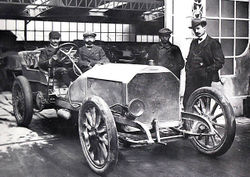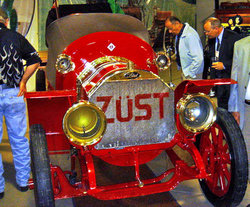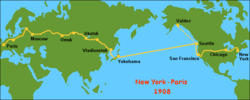Difference between revisions of "Zust"
m |
m |
||
| Line 19: | Line 19: | ||
== 1908 ''Race Around the World'' == | == 1908 ''Race Around the World'' == | ||
| − | [[File:Great_Race_1908_map.png|thumb|250px|right|'''Map of the ''Race Around the World'' | + | [[File:Great_Race_1908_map.png|thumb|250px|right|'''Map of the ''Race Around the World'']] |
Revision as of 19:07, 12 December 2009

1905 - 1917
Early in the century when Roberto ZÜST died (a Swiss-born engineer who had founded a factory for precision machine tools for metal working in Intra, Lake Maggiore), his children in 1905 decided to open a second factory in Milan, to build their own cars and commercial vehicles. The first two ZÜST models had 4-cylinder engines ranging from 7432 cc and 11308 cc. In 1906 a branch was opened in Brescia, which was named Brixia-ZÜST (from the Latin name of Brescia) and was used to produce cheaper cars. After the 14/18 HP (with a 3770 cc engine), the Brixia-ZÜST presented the 18/24 HP, with a 4-cylinder 3770 cc, and 10 hp with a 1386 cc 3-cylinder engine. In 1910, the 10 hp engine was increased to 1501 cc and a batch of 10 copies, of these cars, were exported to London, where they went into service as taxis. In 1911 the 10 HP, 14/18 HP (which had since been increased to 2297 cc) and the 18/24 HP (increased to 4942 cc) were put out of production.
When, in 1912, Brixia-ZÜST was absorbed by ZÜST, it went to the person who had always controlled the shares. ZÜST, meanwhile, had become a household name known throughout the world, participated with a 28/45 HP in the grueling New York - Paris race in 1908. This competition, which was approached by ZÜST with extreme seriousness and commitment despite the unfortunate outcome (the race was won by American Thomas in front of the German Protos). The reliability of the 28/45 HP was shown in this race, along with others. Sometimes they were in least place (the 28/24 HP had to go through the Siberian wilderness, thus repeating the companies accomplished in 1907 by more powerful Itala 35/45 HP during the raid Beijing - Paris).
At the wheel of this glorious ZÜST was the driver Sirtori, his fellow adventure, the mechanic Haaga, and the journalist of the Mattino di Napoli (Morning of Naples), Antonio Scarfoglio. These three brave men had to face hardships of every kind: for example, in America, while they were engaged in the stretch between the Alleghenies and the Rockies were even attacked by a pack of wolves. Ironically, the 28/45 HP, after resisting a thousand hard miles, went accidentally destroyed in the English padock of Bromley, it was completely burned by a fire caused by a porter, who had come in with an acetylene lamp. The productions of ZÜST, around the years of the race New York – Paris, was made up of three models: the 15/25 HP (2853 cc), the 35/50 HP Special GS (6321 cc) and the 50/60 HP later renamed S 235 (7432 cc). In 1913 they presented the new HP 25/35 S 305, characterized by a radiator similar to that of Fiat at the time, with a Biblocco 4712 cc engine. In the period from 1915 to 1916, ZÜST launched the 15/25 HP 365 S with a displacement of 2952 cc.
In October 1, 1917 ZÜST was absorbed by the Officine Meccaniche of Milan, the future OM, one of the ancestors of Fiat and IVECO. Source
1908 Race Around the World
Of the 13 cars entered for the race, seven or lined up for the start. Of the six participants, one of them - a Sizaire-Naudin - broke during the first day of racing. They remained in contention a roadster American Thomas Flyer, an Italian Zust, a German Protos and the French Motobloc DeDion.
With speeds that reached up to 50 km/h, the caravan took over a month to cross the U.S. and, after a brake in Alaska, they took a chip the departed in mid-April to Japan and from there, to Siberia (also by ship} arriving in Vladivostok for the Asian part of the race, on May 24.
The arrival of the winner happened in Paris on July 30, the Flyer, piloted by George Schuster (then 35) and Montague Roberts and the mechanic Harold Brinker were not the first to cross the finish line. Like all good movies and cartoons of races, this was also, if not a villain, a cheeter. The role was played by German pilot Ernst Maas, who assisted by his co-pilot, Hans Knape and the mechanical Hans Koeppen had "gained a little time" in America, embarked on a covert train ride with the Protos for a large segment of the race. Booked 15 days in total time, Knape got second place. The Italian Zust, piloted by Giulio Sirtori - with the support of Henri Haaga and Antonio Scarfoglio - came in third, a month and a half later.
External link
- http://www.targaflorio.info/zust.htm

- Historic 1907 Züst
- The Story of the 28/45 HP Züst No. 127 Great Race – New York to Paris – 1908 (PDF)
| Car Information and Photos by Marque: A - B - C - D - E - F - G - H - I - J - K - L - M - N - O - P - Q - R - S - T - U - V - W - X - Y - Z |
| Motorcycle Information and Photos by Marque: A - B - C - D - E - F - G - H - I - J - K - L - M - N - O - P - Q - R - S - T - U - V - W - X - Y - Z |


